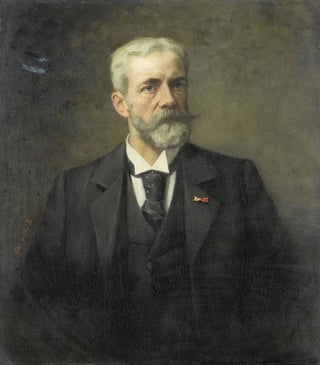Art print | Frederik Danil Otto Obreen 1840-96 General Director of the Rijksmuseum Amsterdam - Thérèse Schwartze


View from behind

Frame (optional)
In the world of art, some works transcend the simple status of decorative objects to become witnesses of an era, reflections of society, and carriers of stories. The art print Frederik Danil Otto Obreen 1840-96 Director General of the Rijksmuseum Amsterdam - Thérèse Schwartze is a perfect example. This piece, which captures the essence of an iconic figure from the late 19th century, immerses us in the fascinating universe of Dutch painting. Through this portrait, Thérèse Schwartze, a renowned artist, manages to immortalize not only the physical appearance of her subject but also his intellectual aura and his prominent role in the art world of his time.
Style and uniqueness of the work
Thérèse Schwartze's style is characterized by meticulous attention to detail and mastery of light that brings her subjects to life. In this work, the color palette evokes a softness and depth that captivate the eye. The way she plays with shadows and lights creates an intimate atmosphere, inviting the viewer to approach and contemplate the face of the Rijksmuseum director. Each brushstroke seems charged with emotion, and the expression of the character exudes a certain wisdom, almost mystical. The composition, for its part, is balanced, highlighting Obreen's imposing stature while incorporating elements of his environment, thus emphasizing his role in the preservation and promotion of art.
The artist and her influence
Thérèse Schwartze, born in Amsterdam, managed to establish herself in an artistic environment dominated by men. Her career is marked by unwavering determination and undeniable talent that allowed her to become one of the first women recognized in the field of painting. Her work is not limited to portraits; it also reflects social tensions and cultural evolutions of her time. By painting influential figures like Frederik Danil Otto Obreen, she not only contributed to the history of Dutch art but also paved the way for other female artists. Her influence endures

Matte finish

View from behind

Frame (optional)
In the world of art, some works transcend the simple status of decorative objects to become witnesses of an era, reflections of society, and carriers of stories. The art print Frederik Danil Otto Obreen 1840-96 Director General of the Rijksmuseum Amsterdam - Thérèse Schwartze is a perfect example. This piece, which captures the essence of an iconic figure from the late 19th century, immerses us in the fascinating universe of Dutch painting. Through this portrait, Thérèse Schwartze, a renowned artist, manages to immortalize not only the physical appearance of her subject but also his intellectual aura and his prominent role in the art world of his time.
Style and uniqueness of the work
Thérèse Schwartze's style is characterized by meticulous attention to detail and mastery of light that brings her subjects to life. In this work, the color palette evokes a softness and depth that captivate the eye. The way she plays with shadows and lights creates an intimate atmosphere, inviting the viewer to approach and contemplate the face of the Rijksmuseum director. Each brushstroke seems charged with emotion, and the expression of the character exudes a certain wisdom, almost mystical. The composition, for its part, is balanced, highlighting Obreen's imposing stature while incorporating elements of his environment, thus emphasizing his role in the preservation and promotion of art.
The artist and her influence
Thérèse Schwartze, born in Amsterdam, managed to establish herself in an artistic environment dominated by men. Her career is marked by unwavering determination and undeniable talent that allowed her to become one of the first women recognized in the field of painting. Her work is not limited to portraits; it also reflects social tensions and cultural evolutions of her time. By painting influential figures like Frederik Danil Otto Obreen, she not only contributed to the history of Dutch art but also paved the way for other female artists. Her influence endures






